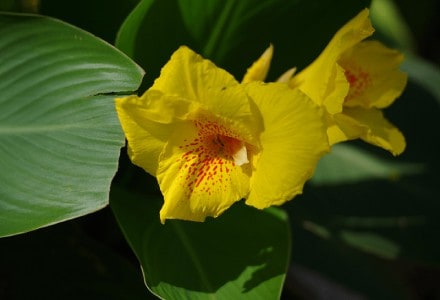
Photographer: Kirt Edblom
CC License: https://bit.ly/2YYNS8C
Canna Lily Facts
- Interestingly, the simple term of Canna Lily serves as the collective name of any of the related flowering plants placed within a specific genus. Currently, scientists place a total of 19 distinct species within this visually and scientifically impressive group.
- Continually ongoing investigations could potentially add to that number, however. The shared name of this remarkable group actually remains somewhat deceptive in nature. Despite that name, this quite beautiful plant does not represent a true lily.
- In point of fact, its closest relatives may actually surprise most of you. That’s because those consist of species most people would never associtate with these magnificent blooms. That’s because they include the various forms on gingers and bananas.
- Numerous tribes of Native Americans also cultivated these incredible plants for centuries. These ancient civilizations clearly recognized their value as more than just visual. In point of fact, various parts of the plant actually hold many surprising uses.
- Due to that, this wonder of Nature holds a special place in the history of its region. It represents one of the earliest domesticated plants in its part of the world. This occurred because, surprisingly, the starchy root itself can be safely consumed.
- Many of the varieties of this remarkable beauty now find themselves facing numerous threats, though. These primarily consist of habitat loss and climate change, like many other species. As a result, several types of Canna Lily now appear on the IUCN Red List.
Related Articles
Cobra Lily Amazon Lily Pine Lily
Public Domain Image
Canna Lily Physical Description
Given the sheer number of different species of Canna Lily, certain characteristics understandably vary. Some of these, in fact, vary somewhat significantly. Conversely, however, some of the basic physical traits naturally remain consistent between each of them.
For starters, all presently recognized members of this genus share the most basic environmental requirements. Each of them further evolved in either of two specific climates. That holds true since all varieties appear as either tropical or subtropical perennial herbs.
Following that, the abundant and remarkable leaves of each of them also display the same basic patterns. That’s due to the fact that the foliage develops as relatively broad and flat in all of the accepted forms. But, the impressive nature of these does not end there.
In fact, these structures grow out of a stem in a long narrow roll and then unfurl to their full extent. Both the leaves and stems of the plants also typically display a solid green color. Sometimes, however, both show either maroon, brownish, or even variegated in color.
All known forms of the Canna Lily further share similarities in the nature of their blooms. That’s because the flowers typically develop with brilliant colors, such as hues as orange, red or yellow. Some forms of this lily sometimes grow to heights of as much as 9.8 ft (3 m).
- Kingdom: Plantae
- Phylum: Angiosperms
- Class: Monocots
- Order: Zingiberales
- Family: Cannaceae
- Genus: Canna
Photographer: Dinesh Valke
CC License: https://bit.ly/2WoNAWQ
Canna Lily Distribution, Habitat, and Ecology
Lamentably, the gorgeous Canna Lily genus evolved as native to a somewhat limited portion of the globe. More specifically, this region consists of the tropical and sub-tropical regions of both Americas. This also includes the southern United States, in North America.
That region mainly consists of the area from South Carolina to Texas. They further appear as deep into South America as parts of the country of Argentina. The genus, however, also now exists in areas with compatible climates throughout the world, due to commerce.
Within their native range, the plants nevertheless only inhabit certain specific climates. They therefore show themselves to be moderately adaptable. The plant nevertheless thrives best in most warm climates, as long as it acquires at least 6-8 hours of sunlight.
Many uses further exist for this remarkable plant, varying in different parts of the world. Some uses of the Canna Lily include using the seeds in the making of jewelry. Others, meanwhile, actually include fermenting the petals to make an alcoholic beverage.
But the usefulness of this fascinating and beautiful flora does not simply end there. That holds true given the fact that it’s also used in the production of a bright purple dye. Some individuals occasionally even use smoke from the burning plant as an insecticide.
Species Sharing Its Range
Opossum Southern Magnolia Lovebug
Check out our other articles on 6 Extraordinary North American Reptiles, Giant Oarfish, Blyde River Canyon, Calleta silkmoth, Pallid Bat, Darwin’s Orchid, Plumed Basilisk

